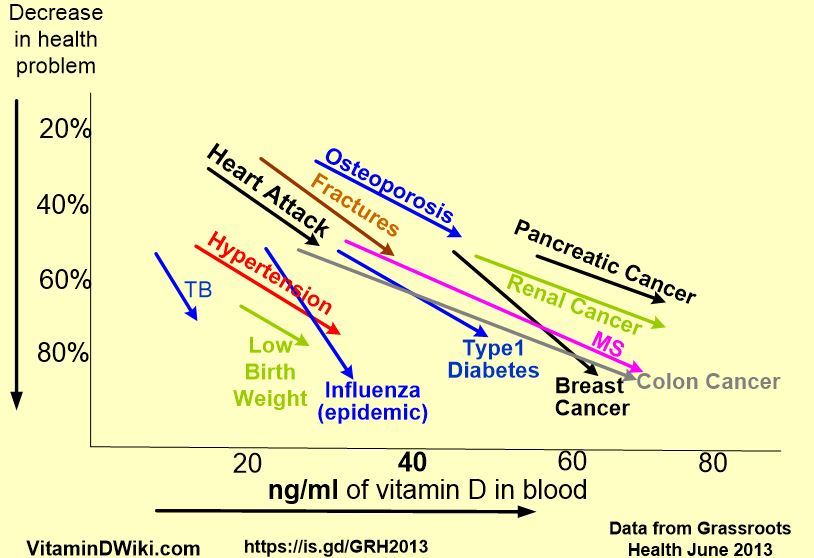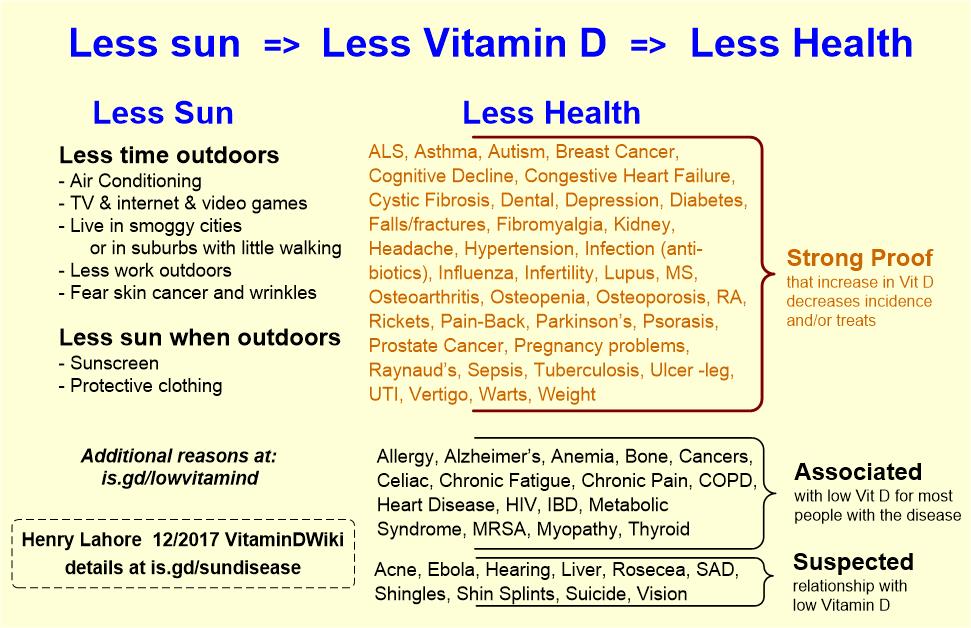Levels of evidence for levels of vitamin D
Does Vitamin D Sufficiency Equate to a Single Serum 25-Hydroxyvitamin D Level
or Are Different Levels Required for Non-Skeletal Diseases?
Nutrients 2013, 5, 5127-5139; doi:10.3390/nu5125127
Simon Spedding Simon Vanlint , Howard Morris 1,3 and Robert Scragg 4
1 Division of Health Sciences, University of South Australia, Adelaide, SA 5000, Australia; E-Mails: spedding@adam.com.au (S.S.); howard.morris@health.sa.gov.au (H.M.)
2 Discipline of General Practice, School of Population Health, University of Adelaide, Adelaide, SA 5005, Australia; E-Mail: simon.vanlint@adelaide.edu.au
3 SA Pathology, PO Box 14, Rundle Mall, Adelaide, SA 5000, Australia
4 School of Population Health, Faculty of Medical and Health Sciences, The University of Auckland, Private Bag 92019, Auckland 1142, New Zealand; E-Mail: r.scragg@auckland.ac.nz
- Author to whom correspondence should be addressed; E-Mail: spedding@adam.com.au; Tel.: +618-8302-1853; Fax: +618-8302-2178.
Received: 28 October 2013; in revised form: 27 November 2013 / Accepted: 28 November 2013 / Published: 16 December 2013
Objective: Clarify the concept of vitamin D sufficiency, the relationship between efficacy and vitamin D status and the role of Vitamin D supplementation in the management of non-skeletal diseases. We outline reasons for anticipating different serum vitamin D levels are required for different diseases. Method: Review the literature for evidence of efficacy of supplementation and minimum effective 25-hydroxyvitamin D (25-OHD) levels in non-skeletal disease.
Results: Evidence of efficacy of vitamin supplementation is graded according to levels of evidence. Minimum effective serum 25-OHD levels are lower for skeletal disease, e.g., rickets (25 nmol/L), osteoporosis and fractures (50 nmol/L), than for premature mortality (75 nmol/L) or non-skeletal diseases, e.g., depression (75 nmol/L), diabetes and cardiovascular disease (80 nmol/L), falls and respiratory infections (95 nmol/L) and cancer (100 nmol/L).
Conclusions: Evidence for the efficacy of vitamin D supplementation at serum 25-OHD levels ranging from 25 to 100 nmol/L has been obtained from trials with vitamin D interventions that change vitamin D status by increasing serum 25-OHD to a level consistent with sufficiency for that disease. This evidence supports the hypothesis that just as vitamin D metabolism is tissue dependent, so the serum levels of 25-OHD signifying deficiency or sufficiency are disease dependent.
only a portion of the text is extracted from PDF which is attached at the bottom of this page
5. Findings
Premature mortality—There is Level I evidence that vitamin D supplementation reduces premature mortality. A Cochrane review of randomized controlled trials (RCTs) showed a 6% reduction in all-cause mortality [23], with observational data from the NHANES and ESTHER studies suggesting a minimum 25-OHD concentration of 75 nmol/L for preventing premature mortality [24,25].
Cancer—There is Level II evidence from one RCT that vitamin D supplementation leads to a substantial reduction in overall risk of internal cancers [26]. The reported minimum 25-OHD concentration for cancer prevention is 100 nmol/L [27] whilst a review shows an inverse, non-linear relationship between 25-OHD levels and cancer risk [28].
Muscle function and falls—There is Level I evidence from a meta-analysis that demonstrated a 26% reduction in falls with vitamin D supplementation [29]. Other meta-analyses [30-32] that included RCTs with design limitations reached a null conclusion [33]. The optimal 25-OHD concentration for lowest risk of falls is 95 nmol/L [34].
There is Level II evidence for the efficacy of vitamin D supplementation in vitamin D deficiency for lower limb muscle strength [35].
Cardiovascular disease—There is Level III-2 evidence that vitamin D protects against cardiovascular disease from three meta-analyses of cohort studies [36,37]. One study of 300,000 person years demonstrated a 39% reduction in IHD in people with high 25-OHD concentrations in comparison with those with severe deficiency and a similar effect on incidence of ischaemic stroke [38]. In another study, Vitamin D supplementation conferred substantial survival benefit (OR for death 0.39p < 0.0001) in cardiac patients [39]. These estimates are very similar to those proposed in an earlier systematic review and meta-analysis by Parker et al. [40]. The reported minimum 25-OHD concentration associated with lowest CVD risk is 80 nmol/L [41].
Respiratory infections—There is Level II evidence that vitamin D supplementation reduces rates of respiratory infections including pneumonia [42], influenza [43] and upper respiratory infections [44]. This is supported by epidemiological studies for tuberculosis [45,46] and other respiratory infections [47-49]. The reported minimum 25OH-D concentration associated with a reduced incidence of viral respiratory infections is 95 nmol/L [50].
Diabetes—There is Level II evidence from two randomized controlled trials that vitamin D supplementation improves insulin sensitivity and decreases insulin resistance [51,52]. This is supported by three meta-analysis of cohort studies, which found low 25-OHD concentrations predicted increased risk of type 2 diabetes [53-55]. The reported minimum vitamin D concentration for reducing insulin resistance is 80 nmol/L [56].
Depression—There is Level II evidence that vitamin D supplementation is effective in treating depression from four RCTs in which supplementation significantly reduced depression in vitamin D deficient depressed patients [56-59]. The reported minimum 25OH-D concentration associated with reduced depression is 95 nmol/L [58].
Dental disease—There is Level II evidence from a RCT for dental caries [60]. There is also evidence from the NHANES database showing that attachment loss (AL) is significantly and inversely correlated with serum 25-OHD concentrations in those aged over 50 years AL was lowest in individuals whose 25-OHD levels exceeded 84 nmol/L [61].
Pain—There is Level II evidence for the efficacy of vitamin D supplementation in chronic musculoskeletal pain patients who are also vitamin D deficient [62]. An RCT in vitamin D insufficient non-Western immigrants in the Netherlands showed a clinically meaningful positive effect on pain 6 weeks after high-dose vitamin D supplementation [63]. No threshold level has been proposed.
Health service utilisation and costs—There is Level III-2 evidence that vitamin D deficiency increases health care utilisation and cost. A large study of health care costs in US veterans found that vitamin D deficiency predicted increased health care costs at all six participating sites [64]. Another study estimated that health care utilisation was 39% higher in vitamin D deficient patients [65]. Vitamin D supplementation may be more cost effective than currently funded prevention programs; single studies show that supplementation appears to be more cost effective than screening programs for bowel cancer [66] and more cost effective than multifactorial interventions for preventing falls in the elderly [67]. Considering the economic burden of disease due to vitamin D deficiency, the estimated benefit of increasing vitamin D status across Western Europe was said to be €187b per year [68], calculated on a population basis the equivalent figure for Australia was $14b per year.
Level of Confidence
I Systematic review of Level II studies
II Randomised controlled trial
III-1 Pseudo-randomised controlled trial
III-2 Comparative study with concurrent controls: non-randomised, experimental trial, cohort study, case-control study, or interrupted time series with a control group
III-3 A comparative study without concurrent controls: historical control study, or two or more single arm study, Interrupted time series without a parallel control group
IV Case series with either post-test or pre-test/post-test outcomes
| Disease | Level of confidence |
nmol of vitamin D |
| Premature mortality | Level l | 75 |
| Falls prevention | Level l | 95 |
| Cancer prevention | Level ll | 100 |
| Respiratory infection prevention | Level ll | 95 |
| Diabetes prevention | Level ll | 80 |
| Depression treatment | Level ll | 75 |
| Musculoskeletal pain management | Level ll | |
| Dental disease | Level lll-2 | >84 |
| Musculoskeletal strength | Level lll-1 | |
| Cardiovascular disease | Level lll-2 | 80 |
| Health service utilisation | Level lll-2 |
See also VitaminDWiki
Can Observational Studies be as good as Random Controlled Trials for Vitamin D
National Institute of Health - Strength of Vitamin D Evidence
-
Click on following charts for more information


